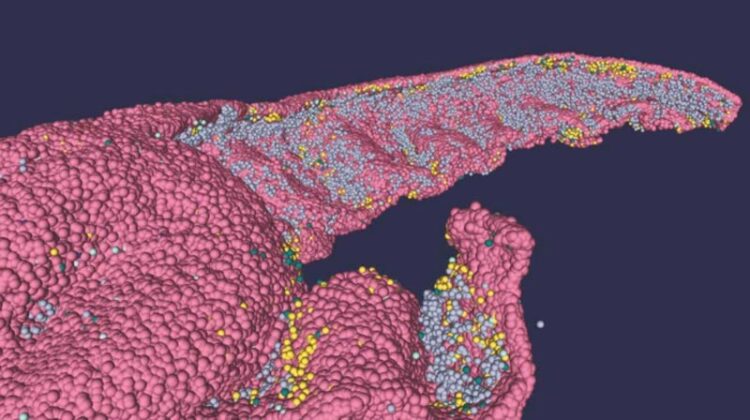New full-scale 3D structural model of the human hippocampus

Researchers of the Human Brain Project have developed a full-scale 3D structural model of the human hippocampus
Credit: Michele Migliore
A new high resolution model of the CA1 region of the human hippocampus has been developed by the Institute of Biophysics of the Italian National Research Council (CNR-IBF) and University of Modena e Reggio Emilia (UNIMORE), part of the Human Brain Project.
The single-cell resolution model, which replicates the structure and architecture of the area, along with the position and relative connectivity of the neurons, was developed from a full-scale dataset of high resolution images. The dataset is available in the BigBrain Atlas and it will be soon available on EBRAINS. According to the study, published in the journal Nature Computational Science, the same methodology could be applied to generate full-scale models of other human brain areas and also to be integrated in a co-simulation environment such as the The Virtual Brain.
“The amount of data on individual neurons of the human brain is very limited, both in terms of relative 3D coordinates and in terms of connectivity among neurons” explains Michele Migliore from CNR-IBF, Palermo. “We have performed a data mining operation on high resolution images of the human hippocampus, obtained from the BigBrain database. The position of individual neurons has been derived from a detailed analysis of these images”.
The researchers have developed a customized image processing algorithm in order to obtain a realistic distribution of neuronal positioning, and an algorithm to generate neuronal connectivity by approximating dendritic and axonal shapes. “Dendrites and axons can be classified into categories depending on the general shape of their extensions: for example, some fit into narrow cones, others have a broad complex extension that can be approximated by dedicated geometrical volumes, and the connectivity to nearby neurons changes accordingly” explains Daniela Gandolfi from UNIMORE, lead author of the study. “Our algorithm analyzes high resolution images and, after the creation of specific geometrical shapes to be associated with morphological properties, allows us to calculate the probability that two neurons are connected. The method provides not only the 3D positioning of neurons, but also their connectivity”.
“We compared the density of neurons in our 3D model with existing literature on the hippocampus, and found that it matches experimental observations, validating our model” concludes Gandolfi. The researchers are sharing both the dataset and the extraction methodology on the EBRAINS platform. “Our main goal with this study was to make the data readily available with HBP and the broader neuroscience community. We are now using the same approach to model other brain regions”.
Text by Roberto Inchingolo
Reference:
Daniela Gandolfi, Jonathan Mapelli, Sergio M. G. Solinas, Paul Triebkorn, Egidio D’Angelo, Viktor Jirsa & Michele Migliore: Full-scale scaffold model of the human hippocampus CA1 area. Nature Computational Science (23 March 2023). https://doi.org/10.1038/s43588-023-00417-2
Research Briefing: A single-cell-resolution mathematical model of the CA1 human hippocampus Nature Computational Science (23 March 2023). https://doi.org/10.1038/s43588-023-00421-6
Further images and videos can be found in the paper.
Journal: Nature Computational Science
DOI: 10.1038/s43588-023-00417-2
Article Title: Full-scale scaffold model of the human hippocampus CA1 area
Article Publication Date: 23-Mar-2023
Media Contact
Peter Zekert
Human Brain Project
press@humanbrainproject.eu
Office: 49-246-161-96860
All latest news from the category: Medical Engineering
The development of medical equipment, products and technical procedures is characterized by high research and development costs in a variety of fields related to the study of human medicine.
innovations-report provides informative and stimulating reports and articles on topics ranging from imaging processes, cell and tissue techniques, optical techniques, implants, orthopedic aids, clinical and medical office equipment, dialysis systems and x-ray/radiation monitoring devices to endoscopy, ultrasound, surgical techniques, and dental materials.
Newest articles
Faster, more energy-efficient way to manufacture an industrially important chemical
Zirconium combined with silicon nitride enhances the conversion of propane — present in natural gas — needed to create in-demand plastic, polypropylene. Polypropylene is a common type of plastic found…

Energy planning in Ghana as a role model for the world
Improving the resilience of energy systems in the Global South. What criteria should we use to better plan for resilient energy systems? How do socio-economic, technical and climate change related…

Artificial blood vessels could improve heart bypass outcomes
Artificial blood vessels could improve heart bypass outcomes. 3D-printed blood vessels, which closely mimic the properties of human veins, could transform the treatment of cardiovascular diseases. Strong, flexible, gel-like tubes…





















